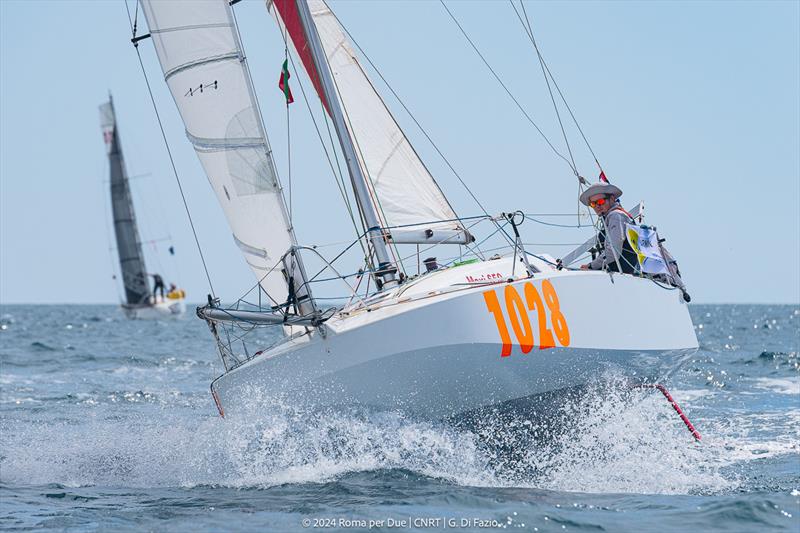
A look at the Mini Transat, the Mini Globe Race, and the upcoming Transat Café L'OR
by David Schmidt 20 Oct 22:00 BST
October 20, 2025

Joshua Schopfer - Mini Transat © Gianluca Di Fazio
Sailing headlines of late might be dominated by big monohulls or foiling multihulls (we'll get there), but there are two interesting races afoot involving big oceans and small boats, namely the Mini Transat and the Mini Globe Race. The former race takes singlehanded sailors racing aboard 21-footers from Les sables d'Olonne, France, across the Atlantic Ocean to Saint-Francois, Guadeloupe (with a stopover in Santa Cruz De La Palma, in the Canary Islands), while the latter is an around-the-world stage race that involves singlehanded sailors racing aboard 19-footers.
Both races involve bravery, seamanship, and a willingness to take on vast and powerful oceans aboard boats that could fit inside most people's garages.
The Mini Transat began on Sunday, September 21, and took a fleet of 33 prototype Classe Minis and 57 series boats from France to the Canary Islands.
While this is largely a Francophile affair, Ambre Hasson, who holds dual American and French citizenships, and who only learned to sail during the opening days of the pandemic, is representing the USA. Hasson sailed On the Road Again II (USA 618) to a sixth-place finish in the highly competitive prototype division in the race's first leg, which is impressive given that her path to the Mini Transat involved a ground-up effort, a wrecked first boat, and a heck of a lot of DIY determination.
Leg Two, which will take the fleet from the Canary Islands across the yawning gap of the North Atlantic to the Caribbean Sea, begins on Saturday, October 25. The race expects frontrunners to reach Guadeloupe sometime around November 7, and its scheduled prize-giving ceremony (slated for Saturday, November 15) suggests about a week of finishing-line time deltas between the hares and tortoises.
Be sure to stay tuned for more from the Mini Transat as news from Leg 2 breaks.
Switching gears to the Mini Globe Race requires a small rewind.
This globe-girdling race began on the waters off Antigua on Sunday, February 23, 2025, and is expected to close the loop on its "lap" sometime in late March, 2026. The race, which is sailed aboard 19-foot Class Globe 5.80 sloops, is contested as a series of stages.
To date, the fleet has visited Panama (they transited from the Atlantic to the Pacific via the Panama Canal), Mystery Island, Tahiti, Tonga, Fiji, Darwin (Australia), the Cocos Islands, and Mauritius, which is where the fleet forerunners are currently situated.
The boats are expected to begin their next leg, to Durban (South Africa), on Monday, October 27. From Durban, they will race to Cape Town, then on to St. Helena, then Recife (Brazil), and back to Antigua.
That's a lot of sailing, alone, aboard a 19-footer.
Fifteen brave souls embarked on the Mini Globe Race back in February, however four skippers have since retired.
North American interests are being represented by Joshua Kali, a Seattle-based climber-cum-sailor who is taking on the planet aboard his homebuilt and American-flagged Skookum,, and Dan Turk, an Ontario-based sailor who is racing aboard his homebuilt and Canadian-flagged Little Bea.
A quick glance at the Mini Globe Race's leaderboard reveals that Renaud Stitelmann, sailing aboard his Swiss-flagged Capucinette, is leading the charge, followed by Dan Turner, sailing aboard his Australian-flagged Immortal Game, and Keri Harris, sailing aboard his British-flagged Origami.
As of this writing, Turk is sitting in fifth place, and Kali is sitting seven spots farther astern.
Meanwhile, in big-boat news, the Transat Café L'OR, which stretches across the Atlantic Ocean from Le Harve, France, to Martinique, is set to begin on Sunday, October 26. This doublehanded race will feature two multihull classes (Ultims and Ocean Fifties) and two monohull classes (IMOCA 60s and Class40s), each of which contest different courses.
The mighty Ultims will sail 6,200 nautical miles and cross the Doldrums twice; the Ocean Fifty multihulls will sail 4,600 nautical miles; the IMOCA 60s will race 4,350 nautical miles, and the Class40s will sail 3,750 miles. According to the race's website, most classes are expected to take 10 to 14 days to complete their course, while the Class40s are expected to take between 12 and 16 days to reach the finishing line.
"Each course is intrinsically different from that of another class," wrote Yann Château, deputy race director, on the event's website. "We will not follow a single transatlantic race but four races. The fact that these new courses are shorter than in some editions will also offer a higher density of boats and therefore a stronger boat-on-boat, head-to-head fight.
"The skippers will not necessarily have time to make big gains on a strategic move," continued Château. "Finally, the arrival in Martinique will bring a share of surprises. The sailors will arrive tested and tired, and they will have to deal with the significant high ground to the south of Martinique, near the Rocher du Diamant, which leads to windless zones."
The event's website suggests that the winning team should arrive in Martinique's Fort-de-France on or around November 5.
Sail-World wishes all these competing sailors great luck in their upcoming transoceanic adventures.
May the four winds blow you safely home.
David Schmidt
Sail-World.com North American Editor